We present detailed end-to-end particle simulations
of a 10 mA, 1.76 MeV electrostatic proton linac designed for a
contraband detection system based on the principle of gamma resonance
absorption. A 10 mA, 40 KeV H- beam is matched by a space-charge-neutralized
single-solenoid LEBT into the first column of a tandem accelerator.
The resulting 0.9 MeV H- beam is then focused by a quadrupole
triplet to a tight waist in a gas stripper. The emerging H+ beam
is matched by another quadrupole triplet into the second column
of the tandem. A HEBT consisting of two quadrupole doublets and
an 81 degree dipole direct the final 1.76 MeV H+ beam downward
to a carbon 13 target, where a horizontal fan of resonant gamma
rays is generated. The Northrop Grumman TOPKARK code is used to
model the linac, including nonlinear space charge forces and the
magnetic and electrostatic fringe fields. Our results include
the extent and location of beam loss, as well as the evolving
shape of the beam distribution.
The Contraband Detection System (CDS) uses a 10 mAmp,
DC, 1.76 MeV Tandem proton accelerator. CDS is being built by
Northrop Grumman and TRIUMF under the auspices of DARPA. The purpose
of the device is to detect explosives and/or illicit drugs in
luggage through the use of gamma ray resonance absorption techniques.
A 40 keV H- beam from a volume ion source, with a normalized emittance of 0.1 mm-mR, is extracted into a space charge neutralized, single solenoid LEBT and matched into the first column of the tandem accelerator, in whose fringe field, positive ions are reflected and a 10 mA current appears. Figure 1 shows 2 RMS Trace 3D envelopes. Trace3D is being run in a 2D mode. The 0.86 MeV H- beam coming out of the first column is then focused by a quadrupole triplet to a tight sub millimeter waist in a gas stripper. The emerging H+ beam is matched by another quadrupole triplet into the second column of the tandem which accelerates it to 1.76 MeV. A HEBT consisting of two quadrupole doublets and an 81 degree dipole directs the final 1.76 MeV H+ beam unto a thin carbon 13 target, where a horizontal fan of resonant gamma rays is generated. The total length of the beamline is less than 10 meters.
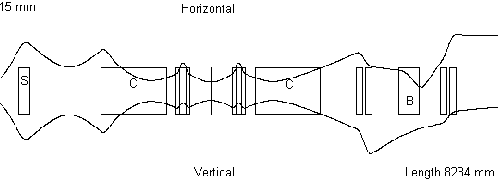
Modifications to the Northrop Grumman ray tracing
code "Topkark" and other codes have been developed for
application to CDS. These modifications encompass a capability
to vary charge and current as a function of length and various
models of the Tandem field. We report on the results of these
applications, complete end to end studies of the device, from
ion source, through the LEBT, first tandem stage, H- to H+ stripper,
second tandem stage and the HEBT. Our principle aims are to avoid
beam scraping in the Tandem and to provide a wide variety of on
target beam shapes.
The Northrop Grumman Topkark code exists in two versions,
a map code, which uses automatic differentiation and a complementary
ray tracing code that simulates individual particle trajectories.
The present study used the latter code and a standard Runge -
Kutta integrator although Topkark is also equipped with canonical
integrators. Topkark implements several 2D and 3D space charge
models, a uniform Trace3D-like model with linear forces, a Gaussian
model, azimuthally symmetric "Parmila" and Gauss Law
models, and a generalized ellipsoidal model due to Garnett and
Wangler.
One critical aspect of modeling CDS is the form of
the radial focusing in the fringe field of the first electrostatic
column as the low velocity, 40 keV beam is rather sensitive. Hence,
we have studied several models for the fringe field, a hard-edge,
impulse model, a model in which the longitudinal field rises linearly
in the fringe region and a model in which the longitudinal field
is a cubic polynomial in the fringe region. In the fringe, the
radial field is given by . In the central
portion of the Tandem the longitudinal field is effectively constant.
Fig. 2 illustrates the near axis fringe fields as calculated with
a charged ring model. The oscillations in Er are due to the finite
ring spacing.
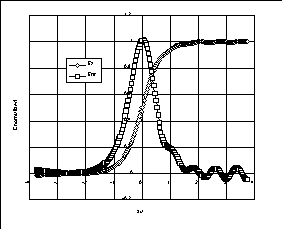
End-to-end simulations of the baseline 10 mA case
with Topkark yield almost no beam loss despite significant space
charge induced nonlinearities. This is not surprising given that
the physical apertures in the device are six times the RMS beam
size. Optically, the CDS device is quite robust. Senarios departing
significantly from baseline are typically apertured limited in
the tandem. Fig. 3 shows the horizontal phase space at the center
of the stripper where the narrowest, 3.5 mm radius aperture is
had.
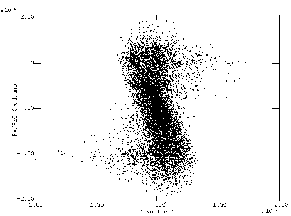
The HEBT is capable of producing a variety of on
target elliptical beam shapes. Figure 4 gives a 3D profile of
one spot geometry. Nonlinearities contributed by the quadrupole
fringe fields are quite small but there is some flattening of
the profile due to space charge forces.
We are also studying ways to increase the cost effectiveness of CDS, including decreasing the size and complexity of the device and increasing the output gamma ray intensity. Figure 5 shows 1 RMS beam envelopes for a doubled current, 20 mA case as produced by the Topkark code. The small discontinuity just after Z equals 1 meter is caused by a 2 RMS scraper. Although the 20 mA beam tends to be generally larger in the tandem, the current CDS configuration should be capable of transporting this larger current without much difficulty.
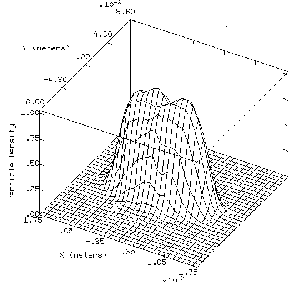
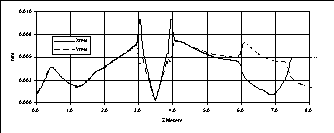
Currently we are conducting end-to-end simulations
with beam input parameters measured at the end of the LEBT. Future
simulation plans include modeling the emittance and divergence
increments caused by the gas stripper.
The following papers at this conference also address the CDS device. "A Contraband Detection System Proof-of-Principle Device Using Electrostatic Acceleration", J. Sredniawski; "Thermo-Mechanical Design of a CW Sweep Plate Emittance Scanner", J. Rathke; "A Sweep Plate Emittance Scanner for High-Power CW Ion Beams", T. Debiak; "Status of the 1.76 MeV Pulsed Light Ion Beamline at the Northrop Grumman ATDC", M. Cole; "Beam Emittance, Transmission, and Intensity Distribution Measurements of the NGC 1.76 MeV Pulsed Beamline and CDS Target Test Facility", S. Melnychuk; "Commissioning of the 40 keV Injector for a Contraband Detection System Proof-of-Principle Device", S. Melnychuk."